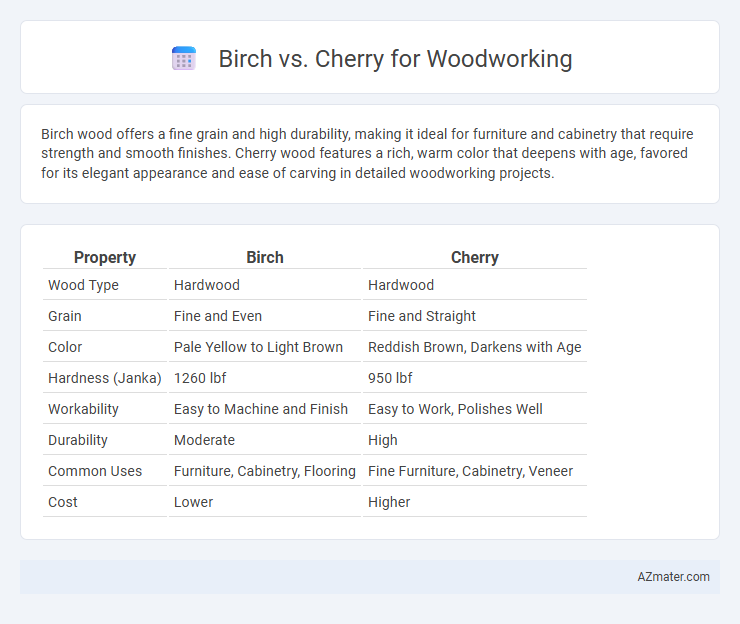Birch wood offers a fine grain and high durability, making it ideal for furniture and cabinetry that require strength and smooth finishes. Cherry wood features a rich, warm color that deepens with age, favored for its elegant appearance and ease of carving in detailed woodworking projects.
Table of Comparison
| Property | Birch | Cherry |
|---|---|---|
| Wood Type | Hardwood | Hardwood |
| Grain | Fine and Even | Fine and Straight |
| Color | Pale Yellow to Light Brown | Reddish Brown, Darkens with Age |
| Hardness (Janka) | 1260 lbf | 950 lbf |
| Workability | Easy to Machine and Finish | Easy to Work, Polishes Well |
| Durability | Moderate | High |
| Common Uses | Furniture, Cabinetry, Flooring | Fine Furniture, Cabinetry, Veneer |
| Cost | Lower | Higher |
Introduction to Birch and Cherry Woods
Birch wood is known for its fine grain, light color, and strong, durable properties, making it a popular choice for furniture and cabinetry. Cherry wood features a rich reddish-brown hue that deepens with age, prized for its smooth texture and elegant finish in high-end woodworking projects. Both woods offer distinct visual appeal and workability, with birch being more affordable and cherry valued for its luxurious aesthetic.
Physical Characteristics: Birch vs Cherry
Birch wood is known for its pale color and fine grain pattern, offering a smooth texture that is relatively hard and resistant to dents, making it ideal for sturdy furniture and cabinetry. Cherry wood features a richer reddish-brown hue that deepens with age, providing a satiny texture and medium hardness that allows for detailed carving and elegant finishes. Both woods have excellent stability, but birch tends to be slightly denser and less prone to warping, while cherry's natural oils improve its durability and resistance to decay.
Workability and Ease of Use
Birch wood offers excellent workability due to its fine, uniform texture and consistent grain, making it easy to machine, sand, and finish for detailed woodworking projects. Cherry wood, while slightly harder, is prized for its smooth surface and natural luster that improve with age, requiring moderate effort when cutting and shaping but resulting in a refined, elegant finish. Both woods respond well to hand and power tools, but birch is generally more forgiving for beginners due to its softer nature and reduced risk of splintering.
Appearance and Grain Patterns
Birch wood features a light, creamy color with fine, uniform grain patterns that provide a smooth, consistent surface ideal for modern and minimalist woodworking projects. Cherry wood showcases rich, reddish-brown hues with pronounced, flowing grain patterns that deepen over time, adding warmth and character to furniture and cabinetry. The subtle contrast between birch's pale, even texture and cherry's vibrant, dynamic grain allows artisans to choose based on desired aesthetic impact and project style.
Strength and Durability Comparison
Birch wood exhibits high strength and impact resistance, making it ideal for heavy-duty woodworking projects requiring durability. Cherry wood offers moderate strength but excels in resistance to wear and natural aging, providing a smooth finish that improves over time. For applications demanding long-lasting structural integrity, birch outperforms cherry in hardness and resilience.
Cost and Availability
Birch wood is generally more affordable and widely available compared to cherry, making it a cost-effective option for woodworking projects. Cherry wood tends to be pricier due to its rich color, smooth grain, and slower growth rate, which limits supply. Birch offers good strength and workability at a lower price point, ideal for budget-conscious woodworkers seeking quality material.
Finishing and Staining Qualities
Birch wood is known for its smooth, even grain, which allows for consistent staining results and a fine finish, making it ideal for projects requiring uniform color. Cherry wood develops a rich patina over time and responds well to staining, enhancing its natural reddish-brown hues with a warm, elegant finish. Both woods are commonly used in fine woodworking, but birch offers more predictability in stain absorption, while cherry provides depth and character through its aging process and finishing qualities.
Best Applications for Birch Wood
Birch wood excels in furniture making, cabinetry, and interior trim due to its fine grain, durability, and smooth finish that takes stain and paint well. Its strength and resistance to shock make it ideal for items requiring durability, such as tool handles and flooring. Birch's light color and consistent texture enhance aesthetic appeal in decorative woodworking projects.
Best Uses for Cherry Wood
Cherry wood boasts a smooth grain and rich reddish-brown hue that deepens with age, making it ideal for fine furniture, cabinetry, and detailed carving projects. Its moderate hardness and stability ensure durability while allowing easy workability with hand and machine tools. Cherry wood's natural oils contribute to a lustrous finish, enhancing its appeal for heirloom-quality pieces and intricate joinery.
Conclusion: Choosing Between Birch and Cherry for Woodworking
Birch offers durability, affordability, and a pale, consistent grain, making it ideal for projects requiring strength and a smooth finish. Cherry provides a rich, warm tone that deepens with age, favored for fine furniture and detailed craftsmanship. Choosing between birch and cherry depends on the desired aesthetic, budget, and project durability requirements.

Infographic: Birch vs Cherry for Woodworking
 azmater.com
azmater.com